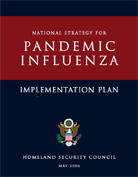Home / Hazards / Influenza| Hazards - Influenza - The Flu |
Influenza (commonly called “the flu”) is a contagious respiratory illness caused by influenza viruses. Infection with influenza viruses can result in severe illness and life-threatening complications. An estimated 10% to 20% of U.S. residents get the flu each year: an average of 114,000 people are hospitalized for flu-related complications and 36,000 Americans die each year from complications of flu. In contrast to natural disasters -- in which critical components of the physical infrastructure may be threatened or destroyed -- an influenza pandemic may also pose significant threats to the human infrastructure responsible for critical community services due to widespread absenteeism in the workforce. H1N1What is influenza?HistoryEmergency Management and Influenza | |
| 

CDC Influenza Page Weekly US Map: Influenza Summary Update 
Implementation Plan
National Strategy for Pandemic Influenza |